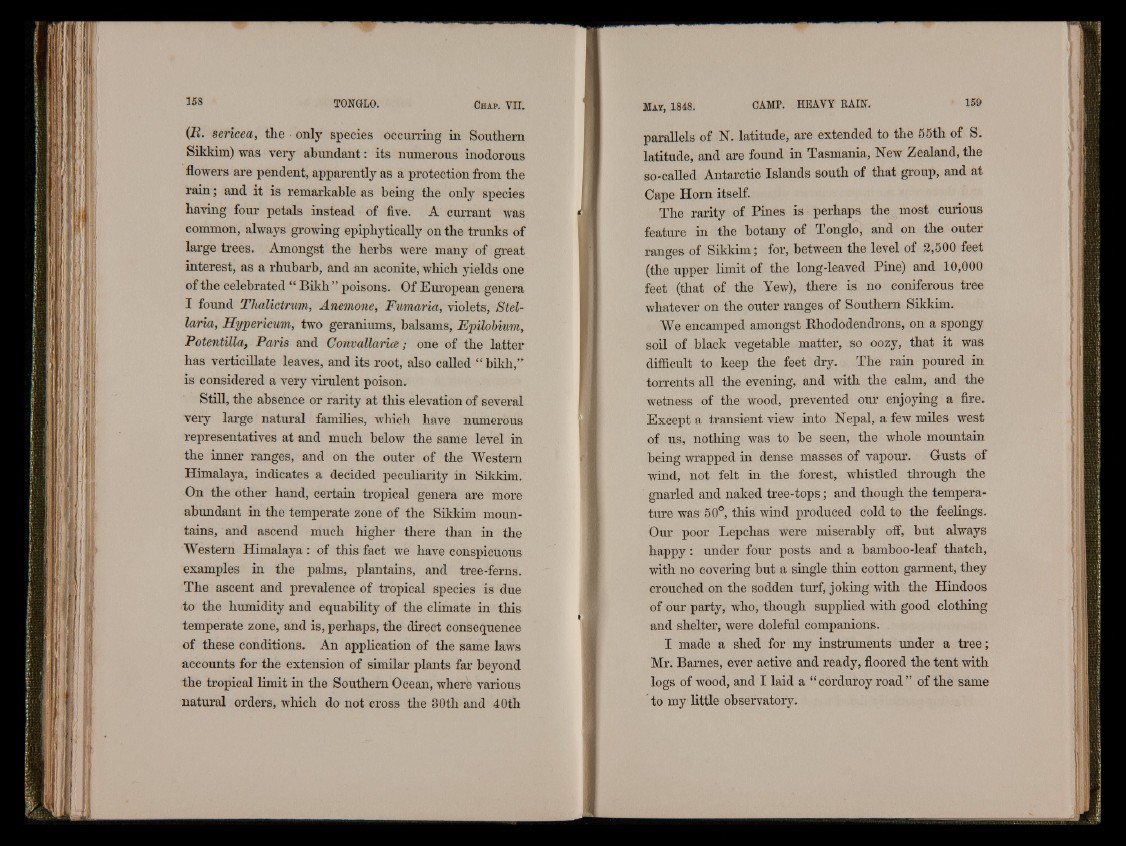
(.R . sericea, the only species occurring in Southern
Sikkim) was very abundant: its numerous inodorous
flowers are pendent, apparently as a protection from the
ra in ; and it is remarkable as being the only species
having four petals instead of five. A currant was
common, always growing epiphytically on the trunks of
large trees. Amongst the herbs were many of great
interest, as a rhubarb, and an aconite, which yields one
of the celebrated “ Bikh” poisons. Of European genera
I found Thalictrum, Anemone, Fumaria, violets, Stel-
laria, Hypericum, two geraniums, balsams, Epilobium,
Potentilla, Paris and Convallarice; one of the latter
has verticillate leaves, and its root, also called “ bikh,”
is considered a very virulent poison.
Still, the absence or rarity at this elevation of several
very large natural families, which have numerous
representatives at and much below the same level in
the inner ranges, and on the outer of the Western
Himalaya, indicates a decided peculiarity in Sikkim.
On the other hand, certain tropical genera are more
abundant in the temperate zone of the Sikkim mountains,
and ascend much higher there than in the
Western Himalaya: of this fact we have conspicuous
examples in the palms, plantains, and tree-ferns.
The ascent and prevalence of tropical species is due
to the humidity and equability of the climate in this
temperate zone, and is, perhaps, the direct consequence
of these conditions. An application of the same laws
accounts for the extension of similar plants far beyond
the tropical limit in the Southern Ocean, where various
natural orders, which do not cross the 30th and 40th
parallels of N. latitude, are extended to the 55th of S.
latitude, and are found in Tasmania, New Zealand, the
so-called Antarctic Islands south of that group, and at
Cape Horn itself.
The rarity of Pines is perhaps the most curious
feature in the botany of Tonglo, and on the outer
ranges of Sikkim; for, between the level of 2,500 feet
(the upper limit of the long-leaved Pine) and 10,000
feet (that of the Yew), there is no coniferous tree
whatever on the outer ranges of Southern Sikkim.
We encamped amongst Rhododendrons, on a spongy
soil of black vegetable matter, so oozy, that it was
difficult to keep the feet dry. The rain poured in
torrents all the evening, and with the calm, and the
wetness of the wood, prevented our enjoying a fire.
Except a transient view into Nepal, a few miles west
of us, nothing was to be seen, the whole mountain
being wrapped in dense masses of vapour. Gusts of
wind, not felt in the forest, whistled through the
gnarled and naked tree-tops; and though the temperature
was 50°, this wind produced cold to the feelings.
Our poor Lepchas were miserably off, but always
happy: under four posts and a bamboo-leaf thatch,
with no covering but a single thin cotton garment, they
crouched on the sodden turf, joking with the Hindoos
of our party, who, though supplied with good clothing
and shelter, were doleful companions.
I made a shed for my instruments under a tree;
Mr. Barnes, ever active and ready, floored the tent with
logs of wood, and I laid a “ corduroy road ” of the same
’ to my little observatory.